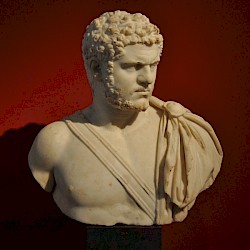Caracalla
 Although we still have to publish the first issue of Ancient History Magazine, we’re already busy with the second one. We have been considering “the Severan age” for some time, and finally decided how to tackle it.
Although we still have to publish the first issue of Ancient History Magazine, we’re already busy with the second one. We have been considering “the Severan age” for some time, and finally decided how to tackle it.
It’s a fascinating period. There’s the spectacular career of the founder of the dynasty, the Libyan senator Lucius Septimius Severus. There’s his sophisticated wife Julia Domna: a Syrian princess surrounded by a circle of mathematicians and scholars. There’s their son Caracalla, who made all freeborn men Roman citizens. And there are the two final emperors, Heliogabalus and Severus Alexander, who are portrayed as a devil and an angel. It’s a great cast.
The Severan age used to be presented as the beginning of the long decline of the Roman Empire. There was a racist element in this analysis: Severus came from Africa and descended from a Semitic family. Julia Domna’s Syrian background stimulated the introduction of Semitic cults. The religious reforms of Heliogabalus (whose nickname is derived from Aramaic Ilaha Gabal, a Syrian sun god) were seen as something terrible.
Of course, our sources do offer indications for this image of the Severan age, but it’s not the whole story. Under Severus, the Roman Empire reached its greatest extent. The legions dealt a knock-out blow to the Parthians, who were left in a crisis from which they never recovered. If the number of inscriptions can be taken as an indication of prosperity, the Empire was never wealthier than under the Severans. Literary life flourished, and so did the visual arts.
In short: the Severan age is an interesting theme for a magazine on ancient history. Classics, art history, archaeology, and philosophy come together. However, we wanted more focus and have considered an issue about Severan art, presented as a continuation of the Antonine art and not as the beginning of a decline. We have also considered religious developments, but in the end settled for the reign of Caracalla.
As I said, he’s the man who gave Roman citizenship to all freeborn Romans. He’s surprisingly well-travelled. He killed his brother. He collaborated with Papinian and Ulpian, famous jurists. He built a famous bathhouse in Rome (and also in Ankara). He fought against the Alamans. He reformed the monetary system. He allowed his mother to play a role in government. He was obsessed with Alexander the Great. His portrait is not what it seems. There’s the dirty story about his death – propaganda that is still unquestioningly repeated.
In short: an interesting subject about which something new can be said. So, our second issue will be dedicated to the reign of Caracalla. If you want to contribute, your proposals are more than welcome!




